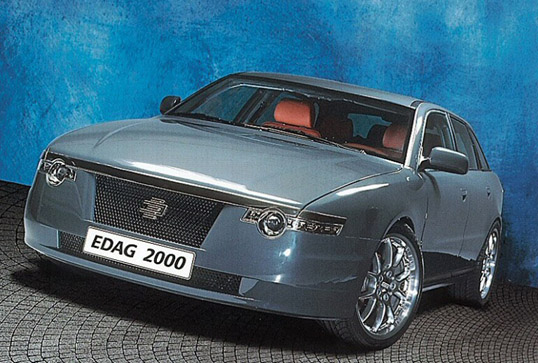 While the concept of the popular car has undergone many changes, representative vehicles, destined for the powerful of this world, was designed over the years to be the same, conservative fashion. Classic drive systems, three-box bodies with large glass area, leather and wood inside, and the chrome on the outside are typical features of limousines, both of the real ones, extended, as well as the exaggeratedly defined elegant sedans "from the top shelf." However, for several years now, there has been an evolution of the view on the car, whose main function is to create the prestige of its user. Paradoxically, vehicles from the years were the inspiration for the restorers of the limousine's image 30. i 40. Primarily striving to reduce the external dimensions of the car while maintaining the spaciousness of its interior, Designers first turned to fashionable single-body bodies. In time, however, they realized, that the cars look more like delivery vans, would not be appreciated by wealthy customers. Here, vehicles from more than half a century ago served as a good model, in which you could sit, without removing the cylinder, and the role of a trunk was often played by an ordinary travel trunk, strapped at the back with leather straps. According to today's criteria, these were undoubtedly two-, and at most two and a half bits. Currently, more emphasis has been placed on the versatility of applications, taking into account the use of the car for other than business purposes, but also recreational, also by the holder's family.
While the concept of the popular car has undergone many changes, representative vehicles, destined for the powerful of this world, was designed over the years to be the same, conservative fashion. Classic drive systems, three-box bodies with large glass area, leather and wood inside, and the chrome on the outside are typical features of limousines, both of the real ones, extended, as well as the exaggeratedly defined elegant sedans "from the top shelf." However, for several years now, there has been an evolution of the view on the car, whose main function is to create the prestige of its user. Paradoxically, vehicles from the years were the inspiration for the restorers of the limousine's image 30. i 40. Primarily striving to reduce the external dimensions of the car while maintaining the spaciousness of its interior, Designers first turned to fashionable single-body bodies. In time, however, they realized, that the cars look more like delivery vans, would not be appreciated by wealthy customers. Here, vehicles from more than half a century ago served as a good model, in which you could sit, without removing the cylinder, and the role of a trunk was often played by an ordinary travel trunk, strapped at the back with leather straps. According to today's criteria, these were undoubtedly two-, and at most two and a half bits. Currently, more emphasis has been placed on the versatility of applications, taking into account the use of the car for other than business purposes, but also recreational, also by the holder's family.
The answer to the question “where are you going to” also looking for Johannes Barckmann, head of the design department of the German engineering company EDAG. His enterprise, like many others in the automotive industry, it had been operating in the shade so far, as an anonymous co-operator, constructing vehicle subassemblies as well as tools and machines for serial production at the request of large corporations, by building prototypes, performing styling work and providing other types of professional services. The proof of EDAG's creative potential is to be a concept vehicle marked with a number 2000 – a vision of a 21st century limousine. It reflects two, currently dominant trends according to Barckmann: striving to provide passengers with both objective driving safety, and the subjective sense of this safety and the phenomenon of the growing popularity of single-body bodies.
The assumptions of the first trend require not only the construction of a rigid passenger compartment (safety cages), but also incorporate it into the architecture of the car body. EDAG body 2000 so they were styled according to the old one, the American principle of "a lot of sheet metal, little glass ", starting from the assumption, that in this form it will immediately inspire the user's trust. In turn, considering the spread of minivans in lower classes as justified, it was decided, that in the case of a representative car, this concept does not exist. It was therefore accepted, like Giugiaro in Buran, 2,5-solid body shape, keeping, however, its proportions at a level similar to that of modern series C / D cars. The strongly emphasized shape of the boot with a small capacity also serves a symbolic and prestigious function, fulfilling traditional ideas about the vehicle for the manager, and at the same time it fulfills the postulate of maximum usable space inside with minimum external dimensions.
The unknown remains, unfortunately, technical details of the study. It is only known, That
it uses mechanical assemblies from one of the renowned manufacturers. The final answer to the question about the directions of development of the car body of higher cars-
upper classes, simplified for the purposes of this article, limousines, however, it belongs to the market.